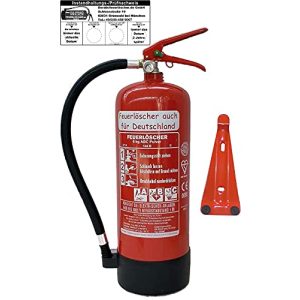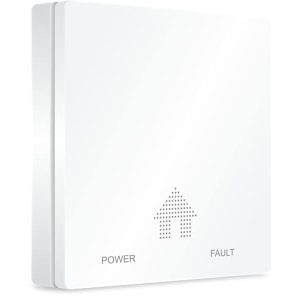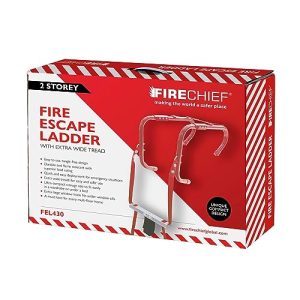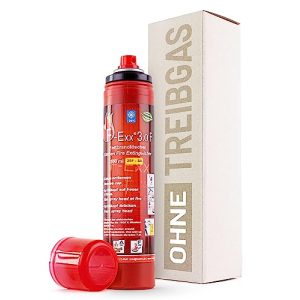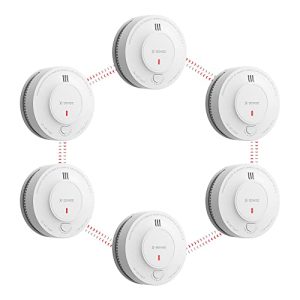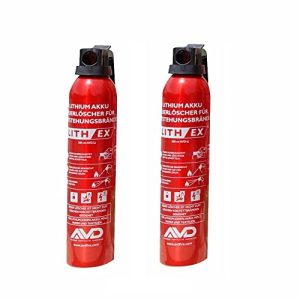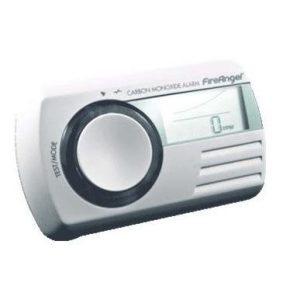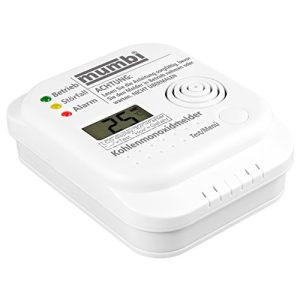Decision support: Carbon monoxide detector test & comparison for the optimal purchase
Find the test winner: How to choose the best carbon monoxide detector for your needs
- Carbon monoxide detectors are vital safety devices designed to monitor the concentration of carbon monoxide (CO) in indoor air. They have sensors that trigger alarms when they detect dangerous levels of CO, allowing them to provide early protection against the risk of poisoning and thus save lives.
- These devices are available for both private and commercial use and are characterized by their ease of use and durability performance and high reliability. Important features of this product category are efficient sensor technology, a loud alarm function and a long battery life. A major advantage of carbon monoxide detectors is that they warn people about this dangerous, invisible and odorless gas even before health symptoms appear.
- Given the high number CO poisoning worldwide and the fact that carbon monoxide cannot be detected by human senses, the importance of carbon monoxide detectors in the security market is undeniably high. They are essential in every home and every industry where carbon monoxide can potentially be released.
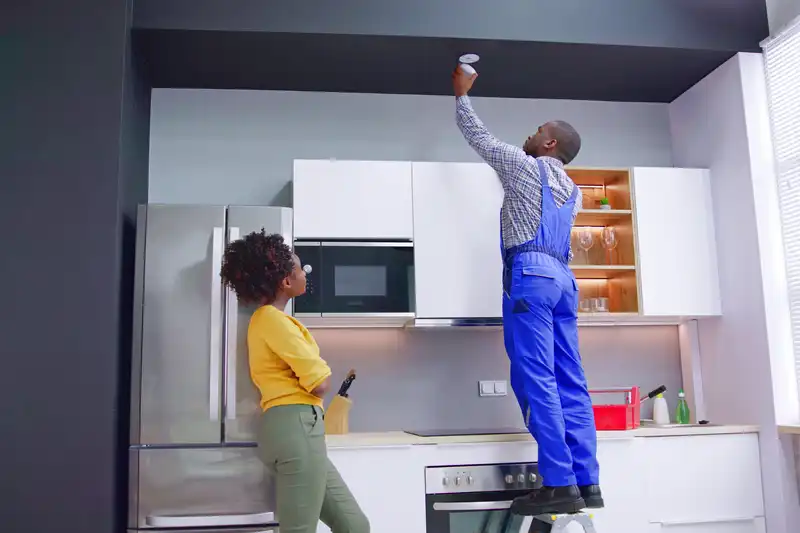
Buying recommendation for the best carbon monoxide detector – safety at the highest level
As someone who always keeps the well-being of my family and those around me in mind, I understand the dangers posed by carbon monoxide. This treacherous gas, odorless and invisible, can occur without a reliable Carbon monoxide detectors remain unnoticed. In my research, I put numerous devices through their paces to ensure you get the best possible protection. Regardless of whether CO detectors, Carbon monoxide detector or part of a comprehensive one Fire alarm system – Your home security system should be reliable Alarm in case of one Carbon monoxide poisoning to be prepared. Believe me, I take this responsibility seriously and will only recommend products that will help you and your loved ones in the event of an impending situation Fire alarm can protect effectively.
Buying overview: Your guide to carbon monoxide detectors
- Carbon monoxide detectors can be life-saving by warning us about the invisible gas.
- It's crucial to choose appliances that are tailored to the individual needs of your household.
- Install CO detectors in strategically important locations to ensure optimal safety.
- Pay attention to devices with audible and visual warning signals so that you are always prepared.
- Maintaining and regularly checking your carbon monoxide detectors is just as important as the initial installation.
- Find out about the standards and recommendations to ensure that your CO detectors comply with safety standards.
- Invest in the Home security is an essential protection for your health and that of your loved ones.
Amazon: Carbon Monoxide Detector – Protect your home from invisible danger
- Carbon monoxide detectors
- German model
- White color
Introduction: The invisible danger of carbon monoxide
Carbon monoxide (CO) is often referred to as the silent killer in our own homes. Its unnoticed presence in the air makes CO particularly dangerous because it cannot be smelled, tasted or seen. As more effective Protection is a reliable one Carbon monoxide detectors, which is able to sound the alarm at an early stage and thus prevent serious damage to health or even death.
Characterization of the gas carbon monoxide
Carbon monoxide is a respiratory toxin that is harmful to health even in small amounts. It occurs when combustion processes of carbon-containing materials are incomplete. CO has the insidious property of quickly spreading through space and binding to hemoglobin in the blood, blocking oxygen transport. In my role as a security consultant, I continually emphasize the urgency of implementing CO sensors as part of domestic security equipment.
Causes and sources of CO emissions in the household
In households, carbon monoxide emissions are often caused by defective or incorrectly operated heating systems that are inadequately maintained Fireplaces and stoves or by using gas-powered appliances without adequate ventilation. Even in modern ones Motorhomes or caravans The risk of CO emissions is present if devices such as gas heaters or cookers are used. It is essential, both gas detector as well as most smoke detector to install and maintain correctly. A combination of Gas alarm system and carbon monoxide alarms are the most effective solution to protect yourself and your loved ones from this invisible threat.
- Various types of Carbon monoxide alarms on the market and understand their functions
- Install devices where the risk of CO production is greatest
- Regular maintenance and professional control of the used CO sensors and smoke detector
What is a carbon monoxide detector and its life-saving role
In my daily work I always come across the question of what a Carbon monoxide detectors is and what significance it has for them home safety has. As an expert in the field of Safety Technology I would like to emphasize that a carbon monoxide detector is an essential device in everyone Budget should be. This small but vital device continuously monitors the air for the presence of carbon monoxide (CO) - an odorless, colorless and deadly gas that, when incomplete Combustion of materials such as wood, coal, gas or oil is created.
A pair of CO Alarm works thanks to built-in electrochemical sensors that react promptly to increased CO levels and warn residents with loud acoustic signals and visual displays before the situation becomes dangerous. This ensures that you can take timely action to protect yourself and your loved ones. The installation and use of carbon monoxide detectors as part of your Fire warning system and yours CO monitoring can literally mean the difference between life and death.
- Safety Technology – Important for the prevention of CO-related accidents
- Fire warning system – Integrated CO detector for comprehensive protection
- CO Alarm – Fast and effective warning in case of danger
- Home safety – Prevents tragic accidents in your own home
- CO monitoring – Constant monitoring of air quality for harmful gases
- Security alarm – Reliable technology for your security around the clock
As a life-saving component in the area of preventive fire protection, carbon monoxide detectors should be installed in all living areas so that they function optimally. Correct placement in combination with regular maintenance ensures the functionality of the Security alarmsso that it warns effectively in an emergency. Personally, I see every CO detector as insurance for the most important thing we have – our lives and that of our family.
How does a carbon monoxide detector work?
When it comes to protecting your home and family from the dangers of carbon monoxide, the front line is CO alarm. Providing timely notification of the presence of CO in the room, also known as the “silent poison”, it is an indispensable safety device. My goal is to understand the technical functionality and the importance of these devices for the Fire prevention to explain and increase understanding of why such a detector should be present in every household.
Principle of electrochemical sensors
At the heart of every CO detection system is a highly sensitive electrochemical sensor. Its main task is to identify and quantify the molecules of carbon monoxide. This detection occurs through a chemical reaction that causes a change in the electrical conductivity within the sensor caused - a clear indication of increased CO levels in the ambient air.

Carbon monoxide is produced by incomplete combustion of combustible materials such as wood, gas, oil or coal and can be fatal if inhaled in high concentrations.
Presentation of warning systems and alarms
A CO detector does not alarm randomly, but rather based on precise threshold values that are defined in the EN 50291 standard. Recognize that CO detection system dangerous CO concentrations, it dissolves one acoustic alarm off, usually accompanied by a visual signal. So-called ones provide additional protection Combination detector, which in addition to CO can also react to smoke or other dangerous gases - an example of progress in the Fire prevention.
My aim is to raise awareness that such a detector is more than just a device; it is a lifesaver that protects you and your loved ones from an invisible danger. That's why he should CO alarm be an integral part of every security concept for your own home.
The importance of a CO detector for your home
As a resident, it is my responsibility to ensure safety within my own four walls. One of the underestimated but essential steps to ensure the Home security is the installation of one Carbon monoxide meter. These devices are vital because CO poisoning are among the most insidious dangers that could lurk in every household.
Carbon monoxide poisoning statistics
The statistics are worrying: almost 3.000 cases of poisoning from this odorless and colorless gas were reported in Germany alone within a decade. Personally, I take these numbers very seriously, because behind every statistic there is a human fate. An efficient one CO measuring device can be the difference between life and death.
Prevention of poisoning through timely warnings
Carbon monoxide binds to the hemoglobin in our blood much more strongly than oxygen. Even small amounts can lead to headaches, dizziness and, in the worst case, unconsciousness. For this reason, it is crucial to have one of the best carbon monoxide detector to install. Such a detector gives us the chance to become aware of an impending danger in good time and to take appropriate measures before it is too late.
- Carbon monoxide meter alerts you if there are abnormal CO values.
- Prevents health damage through timely warning CO poisoning.
- CO measuring device: Your first line of defense against the silent killer.
- Best carbon monoxide detectors: essential for your home and your health.
Different types of carbon monoxide detectors
Choosing a suitable one CO detectors for home is crucial for the security of your own four walls. There are a variety of options on the market today - from simple stand-alone devices to advanced smart detectors that integrate seamlessly into the IoT security equipment one Smart Homes be integrated. In this section I would like to discuss the different types of CO detectors so that you can find the ideal solution for your home.
Stand-alone detectors versus combination devices
The classic CO detector and smoke detector in one device stands for effectiveness and functionality. Combination devices offer the advantage that they combine several safety functions in a single device and thus, for example, smoke development or the escape of other gases such as Natural gas or liquid gas can react. A stand-alone CO Reporter However, it specializes exclusively in the detection of carbon monoxide and is particularly suitable if you already have a separate one smoke detector feature.
Smart home carbon monoxide detectors and networking
Intelligent Smart Reporter represent the next generation of Home security. They can be connected to your home WiFi and enable central monitoring of all networked security devices via your smartphone or Tablet. These send Smoke and CO detectors not only local warning signals, but also inform you about possible dangers in your home while on the move. The networking of various sensors can provide a comprehensive picture of the security situation in real time and thus acts as an integral part of a modern security situation IoT security equipment.
Installation and correct placement of CO detectors
The Installation of carbon monoxide detectors requires care and understanding of how these vital devices work. Around the Installation of CO detectors To do this successfully, it is important to follow certain guidelines. Even modern technology, such as a CO detector with smartphone connection, offers additional comfort and security by transferring usage and alerts directly to your mobile device. But regardless of the technology, correct placement is the be-all and end-all for effective protection.
Positioning guidelines for maximum efficiency
When placing carbon monoxide detectors, there are a few basic rules that I always follow. The detectors are best mounted at breathing height. These should not be more than three meters away from potential CO sources. It is also important not to install in the immediate vicinity of doors, windows or Air currents through fans or extractor hoods, as these can affect the accuracy of the carbon monoxide measurement. For households that use gas heizen, it makes sense to place additional detectors near sleeping areas so that you don't miss any alarm messages while you sleep.
Tips for self-installation and maintenance
For the Installation of carbon monoxide detectors you should study the enclosed operating instructions carefully. Many manufacturers also offer assistance in the form of video tutorials or telephone support. However, if you are unsure or have two left hands, do not hesitate to hire a specialist company to do so Installation of CO detectors professionally takes over. Even after installation, regular maintenance is essential. A test of the alarm signal should be carried out at least once a month, and Batteries must be changed according to the manufacturer's instructions, usually annually. Keep in mind that CO detectors will need to be replaced after about five to seven years as the sensors become less efficient.
Criteria for choosing the best carbon monoxide detector
Security within your own four walls is an essential concern. A crucial factor here is the prevention of carbon monoxide poisoning. To find the ideal Carbon monoxide detector with alarm To find one, there are various aspects to consider that go far beyond a simple price comparison. The Test winner carbon monoxide detector in combination with the right technology can make a significant contribution to increasing household safety and saving lives.
Compare key features and technologies
First is the Type of sensor to be noted. The electrochemical sensors prove to be particularly reliable. A long-term battery is also an advantage to ensure long-term monitoring without frequent battery changes. The ability to connect the device to the domestic one Network or other security systems offers additional added value and makes monitoring easier.
- Electrochemical sensor
- Battery life
- Networking with other security devices
- Accurate alarm threshold based on the EN 50291 standard
- Features such as temperature measurement and event logging
Consideration of room size and specific needs
The size of the room to be monitored is a crucial criterion when selecting the right one Carbon monoxide detector. A living room may need a different model than the bedroom or garage. Specific requirements such as the presence of elderly people or children should also be taken into account, as a faster alarm response may be required.
- Size and nature of the room
- Number of detectors required to completely cover the living area
- Special functions such as displays and additional sensors
In summary, it can be said that in addition to taking into account the Carbon monoxide detector price The technical specifications and space requirements are also important factors in choosing the optimal detector. This way, every household can ensure the protection they need from this invisible killer.
Why carbon monoxide detector?
While smoke detectors are now required for new buildings and renovations in all federal states, carbon monoxide detectors are unfortunately not yet required, even though many households operate a fireplace or one gas heating provides warmth. According to statistics, there were around 375 deaths due to CO poisoning in the last decade. However, the number of unreported cases is much higher because carbon monoxide poisoning is often not recognized or misdiagnosed. Carbon monoxide poisoning is particularly dangerous when it occurs during sleep. Those affected become unconscious without realizing it and suffocate.
First signs are usually not perceived as poisoning symptoms, which are:
- Nausea
- headache
- palpitations
- dizziness
- hallucinations
- apathy
- seizures
- difficulty in breathing
There may be only a few seconds between the onset of symptoms and the loss of consciousness. Already when getting up, the bodily functions can already fail and make it impossible to leave the room.
All incinerators must be properly drained. Modern heating systems are inspected once a year by the district chimney sweep. However, if a heating system is poorly maintained or defective, it may lead to the escape of CO gas. With fireplace heaters, old stove heaters or too well insulated apartment, which is not supplied enough with fresh air, it can also lead to a dangerous concentration of carbon monoxide.
Carbon Monoxide Detector Advantages / Disadvantages
Benefits
alarms
often with early warning system
reduce your recruitment costs
lifesaving
Disadvantages
Gas sensor ages
Mostly after 7 years new purchase necessary
What differentiates carbon monoxide detectors and gas detectors?
A carbon monoxide detector is in principle also a gas detector; carbon monoxide only occurs in a gaseous state. Natural gas or liquefied petroleum gas has a different density than carbon monoxide. While the carbon monoxide alarm is only reported via a carbon monoxide alarm when there is carbon monoxide, a gas alarm only warns when gases are escaping higher density, such as natural gas from gas heaters or gas stoves, which could cause an explosion. He can also Caravan be used to prevent liquid gas from escaping Butane or propane to warn.
How does a carbon monoxide detector work?
A carbon monoxide detector is usually a small, handy and compact device that is attached to the wall and on the ceiling can be attached or placed on a piece of furniture. Special sensors inside measure the carbon monoxide concentration in the air. There is a sensor cell with tin oxide in the carbon monoxide alarm. The carbon monoxide passing there oxidizes into the less dangerous carbon dioxide. This conversion affects the conductivity of the sensor cell, evaluates this change in resistance and triggers a carbon monoxide alarm.
Which gas density is dangerous?
If the danger potential is low when the gas density is low, the carbon monoxide detector works with a time delay; when the gas density is higher, a carbon monoxide detector triggers the carbon monoxide alarm immediately. The duration of the time delay is precisely defined. The gas density is measured in ppm. Ppm stands for “parts per million”. pros Million. At a level of 100ppm or more, the carbon monoxide alarm goes off immediately; at 33ppm, the carbon monoxide alarm only sounds after 120 minutes. If a low concentration increases by 50ppm, the carbon monoxide detector will sound an alarm after just 60 to 90 minutes.
Due to the sensitive gas sensors carbon monoxide alarms usually have no long life. Most manufacturers give for her Carbon monoxide alarm offer a lifetime of 7 years. Thereafter, the CO alarm must be replaced with a new device.
Another safety aspect that needs to be considered is the power supply. Since most carbon monoxide detectors are equipped with batteries, a check of the function is recommended. The battery voltage lasts about one year. At our Carbon monoxide alarm rating from different manufacturers, however, we found that both the best carbon monoxide alarms as well as almost all other devices are equipped with a battery indicator, which signals the replacement in good time.
Where to install carbon monoxide alarm?
It is of relatively little use if your carbon monoxide alarm is installed in the boiler room and you are on the upper floor sleep. The beep is very loud, but lasts for several Floors or hardly notice closed doors while sleeping. That's why it's important Carbon monoxide alarm low to be installed so that it triggers where it is noticed. As a guideline, you can select the rooms where you would also house your smoke detectors.
boiler room
This is where a carbon monoxide alarm is heard when heating with gas, coal or pellets
Corridors or floors
If possible, a carbon monoxide alarm should be present in corridors or on each floor.
Living space
If a fireplace is installed here, you will need a carbon monoxide alarm. A particular danger arises from the simultaneous use of the fireplace and Hood out of. A negative pressure could arise that pushes harmful CO gas out of the chimney into the room.
Carbon monoxide alarm in the bedroom
Im Bedroom is a Carbon monoxide alarm low Installed. There he is within reach and earshot at night. Dust and dirt does not defile it.
cuisine
Neither should be in a kitchen Smoke - another CO detector be attached. Smoking oil or high humidity could lead to false alarms.
Bath
In the bathroom, however, there is also the moisture problem. But if a gas boiler is installed here, it is also a Gas detector low.
Workshop, garage or other Nebengelasse
If the rooms are heated with gas, coal & CO, it is also important to protect yourself from harmful CO gases.
Are there also crosslinkable carbon monoxide detectors?
For the sake of completeness we want you still the Radio carbon monoxide alarm imagine the per WiFi and corresponding app report a CO concentration that is too high. However, since it is not always guaranteed that you carry your smartphone with you, this can lead to a false sense of security, but is definitely recommended as a support for a stationary gas detector. Radio-networked carbon monoxide alarms are quite useful in larger houses or businesses. If a detector responds to a carbon monoxide alarm, all other detectors are activated.
Carbon monoxide alarms what to do?
A carbon monoxide alarm should always be installed at a visual level. A height between 1,50 and 2,0 meters would be ideal. So he's out of it reach of children and can still be operated. You should also always have your detector in sight. Obstacles such as furniture or curtains can also limit functionality. A carbon monoxide detector should also not be placed near a standing or ceiling fan be attached and not next to ventilation equipment, such as window or bath ventilator. Also avoid areas without air circulation such as gable roofs or niches. Some models from the Carbon monoxide alarm offer but can also be set up on a table or sideboard. Some detectors already show a low concentration in the room with a bar chart before any carbon monoxide alarm is triggered. So you can ventilate in time, before a concentration increases dangerously high.
What makes a carbon monoxide detector bestseller?
The Carbon monoxide alarm rating of the different models has resulted in a different picture. The carbon monoxide alarm models are manufactured with different functionality. This concerns the type of power supply, the life and also the Carbon monoxide alarm price. Some are equipped with a visual display in addition to the acoustic alarm, others have a meaningful display. But it doesn't have to be a professional carbon monoxide detector; even the models that aren't necessarily the most expensive will do the job. The Most models have three colored ones LED's. One green LED indicates the operating status, a red alarm. With the yellow LED an error is signaled, which indicates, for example, a weak battery.
In addition to the alarm feature the best carbon monoxide alarms Models a so-called pre-alarm. If the measured values lie below 50ppm, a flashing LED alerts you to the increased value. Some models also show this with a red bar, which appears larger or smaller depending on the saturation of the breathing air. In addition, the display shows the current measured value.
Convenient carbon monoxide alarms also offer the option of saving the values. Others carry out a self-test. If something is wrong there will be a flashing LED in the display pointed out the deficiency. So that a triggered alarm doesn't annoy you with its shrill tone, some detectors have a mute button. In the meantime, you can try to ventilate to reduce the carbon monoxide levels in the air.
Most carbon monoxide alarms are powered by one or more batteries. As is standard with smoke detectors, some are available Carbon monoxide alarms Bestseller also has a permanently installed long-life battery, which usually has a lifetime up to 10 years and makes a battery change unnecessary. Since the sensor is worn out after a maximum of 7 to 10 years, the complete carbon monoxide alarm is replaced with a new one. Also can one Carbon monoxide alarm low can be operated via a 230 V mains connection or is equipped with a radio module. Multiple carbon monoxide alarms can be set via radio Detectors networked together in a building become. The alarm is then passed on from one detector to another.
Small carbon monoxide alarms Kaufberatung overview
buying criteria
- Power Supply
Choose between battery operation, long-life battery without change over the entire period of use, network operation or radio networking
- Advertising
Carbon monoxide alarm devices with a display for reading the measured values are the most convenient, but devices equipped with three colored LEDs to indicate function, error or alarm are also sufficient.
- test function
All CO detectors have a function test button, and the carbon monoxide detectors that perform a self-test are very convenient.
- Pre-alarm
A very convenient feature that displays slow saturation of harmful CO gases.
- mute switch
If an alarm is triggered, you must act quickly to improve the air you breathe. It's quite annoying loud alarm it can be switched off using a mute switch.
- Memory function
Saving measured values can be useful if a certain recurring enrichment can be measured. Should this be the case, the expert has to get to the source of high CO values.
- Design
As always, this is a matter of taste, as with all other devices.
Where to buy carbon monoxide alarms?
Carbon monoxide alarm Detectors are available in all well-stocked construction or media stores. However, the overview of the large number of manufacturers remains on the track and a more detailed Carbon Monoxide Alarm Price Comparison equal to. The Carbon monoxide alarm offer The different versions are the largest on the Internet. It does not matter if you Carbon monoxide alarms opinions If you want to read other portals, if you are interested in the carbon monoxide alarms reviews from customer reviews or want to buy a carbon monoxide alarm reduced, here you will find it.
Is there a Stiftung Warentest carbon monoxide detector test report?
Unfortunately, there is no such an important device yet Carbon monoxide detector test, only a message to measure the carbon monoxide content by the chimney sweep in pellet heating or fireplaces. On Carbon monoxide detector test winner is the device that warns you in good time of a fatal concentration of CO gases.
Amazon carbon monoxide detector: early warning system for safe living and restful sleep
- Only the use of carbon monoxide detectors in accordance with DIN EN 50291 is permitted!
- The CO detector - reacts to carbon monoxide (CO) using an electro-chemical sensor
- Includes battery, dowels and screws = simple, wireless, quick installation
The legal situation and recommendations in Germany
In Germany I am faced with the decision of whether to install a carbon monoxide detector in my household, even though there is no explicit one Carbon monoxide detectors are mandatory in Germany gives. smoke detector are already an integral part of the legal requirements, but carbon monoxide detectors have so far only been recommended. The Fire Department Association regularly points out the importance of these lifesavers, especially for apartments and houses with fireplaces, gas heaters or other potential sources of CO. Following the safety recommendations, I should not wait for official regulations, but rather proactively equip my home.
The way food is Safety standards for carbon monoxide detectors, which are specified by standards such as EN 50291, play an important role in my selection. These standards ensure that the detectors reliably and effectively warn of the dangers of carbon monoxide poisoning. When purchasing, I make sure that the product meets this standard and check that the manufacturer adheres to the performance parameters.
Ultimately, my decision for a CO detector is not just a question of safety, but also of trust in the quality of the product. That's why I'm interested in Carbon monoxide detector with guaranteeto be protected in the event of a defect or malfunction. By choosing a device with a substantial warranty, I ensure that I and my family are protected for the long term. My safety and that of my loved ones should always be our top priority.
FAQ
What is carbon monoxide and why is it dangerous?
Carbon monoxide (CO) is a colorless, odorless, and tasteless gas produced by the incomplete combustion of carbon-containing materials. It is dangerous because it binds to hemoglobin in the blood and prevents oxygen from being transported throughout the body, which can lead to serious health problems or death.
What is the difference between a carbon monoxide detector and a smoke detector?
A carbon monoxide detector only detects the presence of CO in the ambient air and warns of dangerous concentrations using acoustic and visual signals. A smoke detector On the other hand, it reacts to smoke particles in the air that arise in the event of a fire, for example, and is therefore an important part of the Fire prevention.
How do carbon monoxide detectors work?
Carbon monoxide detectors use electrochemical sensors that respond to the presence of CO gas in the air. When a dangerous concentration is reached, the devices trigger an alarm to warn residents in good time and give them the opportunity to leave the building or provide ventilation.
Where should I install a CO detector?
CO detectors should be installed in all living areas, especially near bedrooms, so that the alarm can be heard even at night. Devices should be placed near, but not directly above, potential CO hazard sources, nor should they be hung near windows, doors, or sources of strong drafts.
How often should I service or replace my carbon monoxide detector?
Maintenance of a CO detector includes regular functional tests and replacing the batteries according to the manufacturer's instructions. Many CO detectors have a lifespan of around 5-7 years. Check your device's specifications to determine the exact lifespan and when to replace it.
Are there smart home-enabled carbon monoxide detectors?
Yes, there are CO detectors that can be integrated into smart home systems. These devices can send notifications to you in the event of an alarm Smartphone send and allow you to monitor the status of your detectors remotely.
Can a CO detector also detect other gases?
Default CO detectors are specific for detecting carbon monoxide designed. However, there is also Combination detector, which can also detect other gases such as natural gas or liquid gas in addition to CO. This depends on the respective device and its sensors.
Is purchasing a carbon monoxide detector required by law?
In Germany, the installation of carbon monoxide detectors is not yet legally required, unlike smoke detectors. Nevertheless, the installation of CO detectors is recommended by professional associations to protect against the dangers of CO poisoning.
How do I determine which carbon monoxide detector is best for my home?
When choosing the best CO detector, you should consider features such as sensitivity, alarm strength, connectivity, battery life, and additional features such as display indicators for CO levels. Also consider the size and conditions of your living space and the placement of possible CO sources.
What safety standards apply to carbon monoxide detectors?
CO detectors should comply with the European standard EN 50291, which specifies the requirements and test methods for the devices. It is recommended to choose devices that also have recognized quality seals and come from trustworthy manufacturers.

